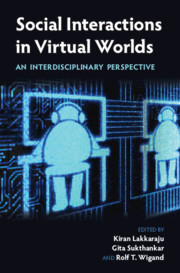Book contents
- Social Interactions in Virtual Worlds
- Social Interactions in Virtual Worlds
- Copyright page
- Contents
- Contributors
- Introduction
- Part I Individual Behaviors and Dyadic Relationships
- Part II Groups: Norms, Leadership, and Virtual Organizations
- Part III Understanding Culture with Games
- Part IV Techniques for Analyzing Game Data
- References
Part III - Understanding Culture with Games
Published online by Cambridge University Press: 15 June 2018
- Social Interactions in Virtual Worlds
- Social Interactions in Virtual Worlds
- Copyright page
- Contents
- Contributors
- Introduction
- Part I Individual Behaviors and Dyadic Relationships
- Part II Groups: Norms, Leadership, and Virtual Organizations
- Part III Understanding Culture with Games
- Part IV Techniques for Analyzing Game Data
- References
Summary

- Type
- Chapter
- Information
- Social Interactions in Virtual WorldsAn Interdisciplinary Perspective, pp. 251 - 310Publisher: Cambridge University PressPrint publication year: 2018

